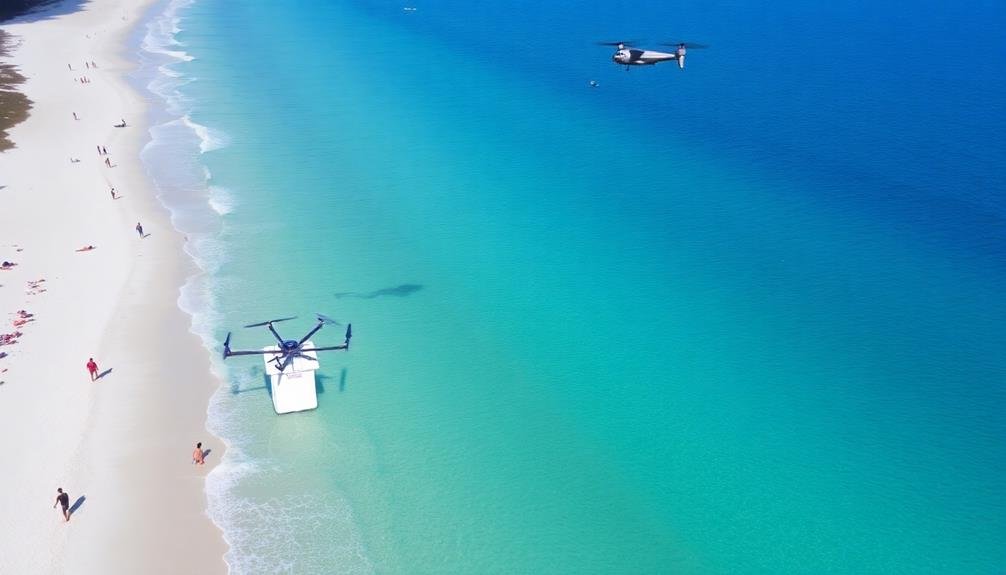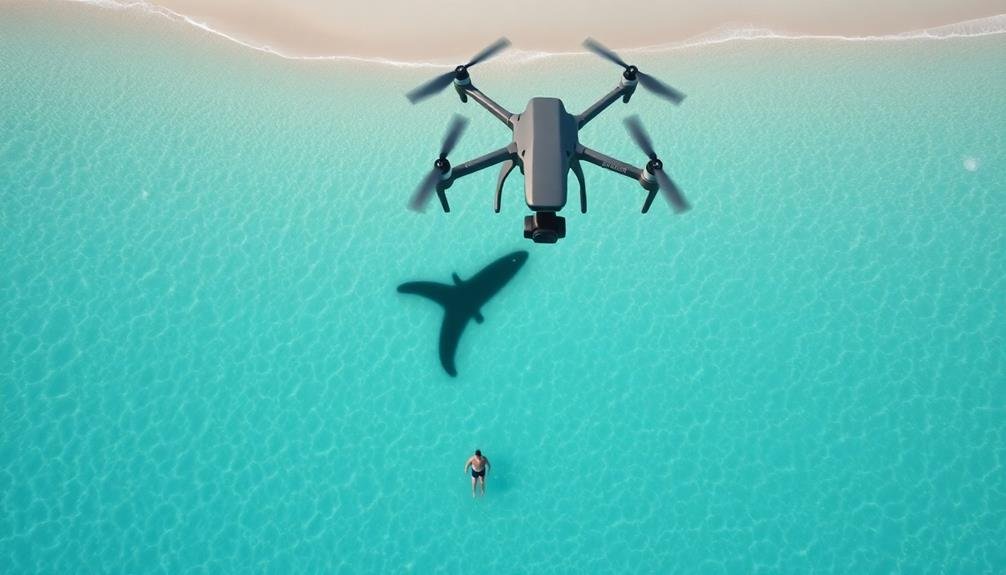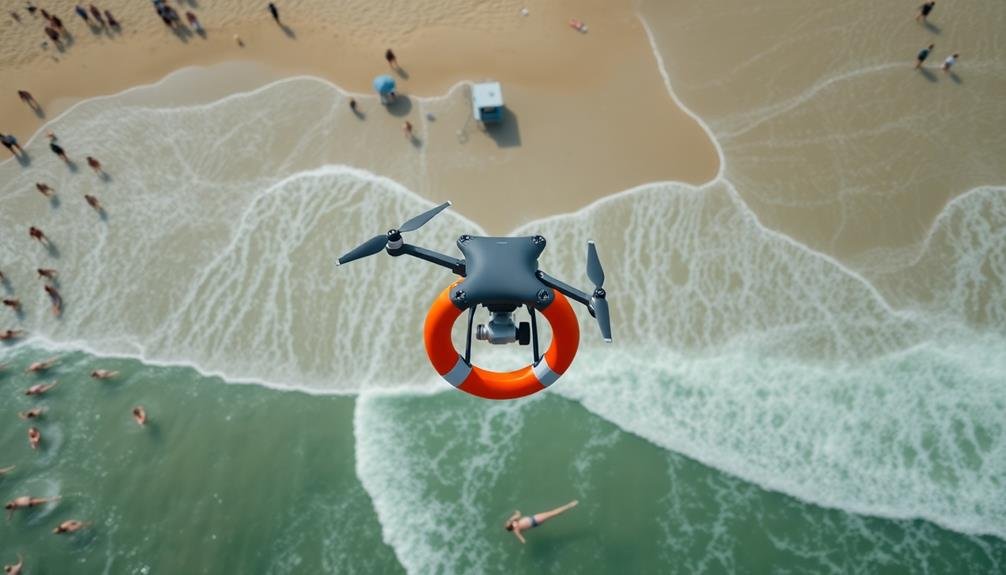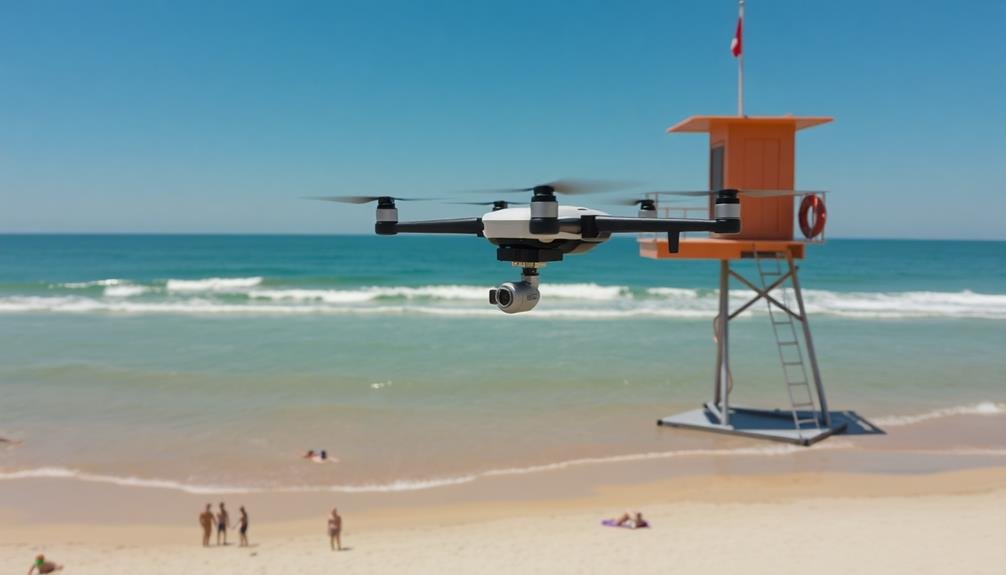Drones are transforming beach safety patrols with their aerial surveillance capabilities. They provide extensive views of shorelines, quickly detect rip currents, and spot sharks using advanced cameras and AI. You'll benefit from their ability to deliver emergency equipment like life jackets and first aid kits to hard-to-reach areas. Drones enhance communication among lifeguards, offering real-time information about hazards and guiding rescue teams to precise locations. They can even broadcast warnings to large crowds in multiple languages. With drones, beach safety teams can cover more ground, respond faster, and predict potential dangers. Discover how these high-tech helpers are revolutionizing coastal safety.
Aerial Surveillance and Monitoring

Drones' eagle-eye view revolutionizes beach safety patrols. You'll find that these unmanned aerial vehicles provide a thorough perspective of the entire shoreline, allowing lifeguards to monitor vast stretches of beach simultaneously.
With high-resolution cameras and real-time video feeds, drones can quickly identify potential hazards, such as rip currents, sharks, or struggling swimmers.
You can use drones to conduct regular sweeps of the beach area, detecting patterns in crowd movement and identifying isolated swimmers who may be at risk. They're especially useful during peak hours or in areas with limited lifeguard coverage.
Drones can also assist in tracking weather conditions, helping you anticipate sudden changes that might affect beachgoers' safety.
In emergencies, drones serve as your eyes in the sky, guiding rescue teams to precise locations and providing essential information about the situation.
They can even drop life-saving equipment to distressed swimmers before human rescuers arrive.
Swift Rip Current Detection

One of the most dangerous threats to beachgoers is rip currents, and drones have become invaluable tools for their swift detection.
You'll find that these aerial devices can quickly scan large areas of water, identifying telltale signs of rip currents that might be difficult to spot from the ground. By using drones, lifeguards and beach patrols can react faster to potential dangers, potentially saving lives.
Drones equipped with high-resolution cameras and thermal imaging technology can detect rip currents by observing:
- Changes in water color
- Patterns of breaking waves
- Sediment movement in the water
- Temperature differences in the current
You'll appreciate how drones can provide real-time data to beach safety teams, allowing them to make informed decisions about closing off dangerous areas or repositioning lifeguards.
They're also useful for tracking the development and movement of rip currents over time, helping predict where they're likely to form in the future.
With this technology, you're not only improving immediate safety but also contributing to long-term risk management strategies for beaches.
Shark Spotting From Above

How can beachgoers feel safer knowing there's an eye in the sky watching for sharks? Drones equipped with high-resolution cameras and AI technology offer a revolutionary approach to shark detection. You'll benefit from their ability to cover vast areas of water quickly and efficiently, spotting potential threats before they reach the shore.
These aerial guardians use advanced image recognition software to distinguish sharks from other marine life. They can identify different shark species, assess their behavior, and determine the level of risk they pose. When a shark is detected, the drone operator can immediately alert lifeguards and beach authorities, allowing for swift action to guarantee your safety.
You'll appreciate the real-time monitoring that drones provide, as they can track shark movements and predict their trajectories. This information helps lifeguards make informed decisions about closing beaches or issuing warnings.
Additionally, drones can deploy shark deterrents or life-saving equipment to swimmers in distress, further enhancing your safety. With drones on patrol, you can enjoy your beach day with greater peace of mind, knowing that an extra layer of protection is watching over you from above.
Emergency Equipment Delivery

Lifesavers in the sky, drones are revolutionizing emergency equipment delivery on beaches. You'll be amazed at how quickly these aerial helpers can respond to emergencies, especially in areas that are hard to reach by foot or vehicle.
They're capable of carrying and dropping essential lifesaving equipment directly to those in need, potentially saving precious minutes in critical situations.
Here's what drones can deliver in beach emergencies:
- Life jackets and flotation devices
- First aid kits and medical supplies
- Defibrillators for cardiac emergencies
- Communication devices for stranded individuals
You'll find that drones can cover large areas of coastline much faster than traditional beach patrols. They can navigate rough terrain and bypass obstacles that might slow down ground-based responders.
In cases of rip currents or strong waves, drones can deliver flotation devices to struggling swimmers before lifeguards arrive. They're also useful in providing supplies to lifeguards already on the scene, allowing them to focus on rescue efforts without leaving the victim.
With drones, you're looking at a future where beach safety is greatly enhanced, and response times are dramatically reduced.
Enhanced Communication for Lifeguards

Drones are flying up and over traditional communication barriers for lifeguards, revolutionizing how they coordinate and respond to emergencies.
You'll find that these aerial assistants provide a bird's-eye view of the beach, allowing lifeguards to communicate more effectively with each other and beachgoers.
With drones, you can relay real-time information about potential hazards, such as rip currents or shark sightings, to lifeguard stations along the coast.
They're equipped with high-resolution cameras and loudspeakers, enabling you to spot distressed swimmers quickly and issue warnings to large crowds simultaneously.
You'll appreciate how drones enhance your ability to coordinate rescue efforts.
They can guide rescue teams to precise locations, reducing response times and improving outcomes.
Additionally, you can use drones to monitor crowd density and movement, helping you allocate resources more efficiently during busy periods.
These flying communicators also bridge language barriers.
You can program them to broadcast messages in multiple languages, ensuring that safety information reaches all beachgoers.
Frequently Asked Questions
How Much Do Beach Safety Drones Typically Cost?
You'll find beach safety drones typically cost between $1,000 to $10,000. The price varies based on features like camera quality, flight time, and durability. High-end models with advanced capabilities can exceed $20,000 for professional use.
What Training Is Required for Lifeguards to Operate Beach Safety Drones?
You'll need specialized drone training to operate beach safety drones. You'll learn flight controls, safety protocols, and emergency procedures. You'll also practice using drone cameras and sensors to spot swimmers in distress. Certification may be required.
Are There Privacy Concerns Associated With Using Drones for Beach Surveillance?
You're right to be concerned about privacy. Drones can capture images of beachgoers, raising issues of consent and data protection. You'll want to guarantee there are clear policies on drone usage, data storage, and public notification.
How Do Weather Conditions Affect the Performance of Beach Safety Drones?
Weather conditions greatly impact beach safety drones. You'll find they struggle in strong winds, heavy rain, or fog. They can't fly in thunderstorms. Sunlight glare may affect camera performance. Sand can damage rotors during takeoff and landing.
What Regulations Govern the Use of Drones for Beach Safety Patrols?
You'll need to comply with FAA regulations for drone operation, including registration, pilot certification, and flight restrictions. Local laws may also apply. Always check with your city's authorities for specific beach patrol drone guidelines.
In Summary
You've seen how drones can revolutionize beach safety patrols. They'll give you a bird's-eye view for better surveillance, help you spot rip currents and sharks faster, and even deliver lifesaving equipment when seconds count. With drones, you'll communicate more effectively and cover more ground. As technology advances, you'll find even more ways to integrate these flying helpers into your beach safety operations. Embrace this innovative tool to keep beachgoers safer than ever before.

As educators and advocates for responsible drone use, we’re committed to sharing our knowledge and expertise with aspiring aerial photographers.




Leave a Reply